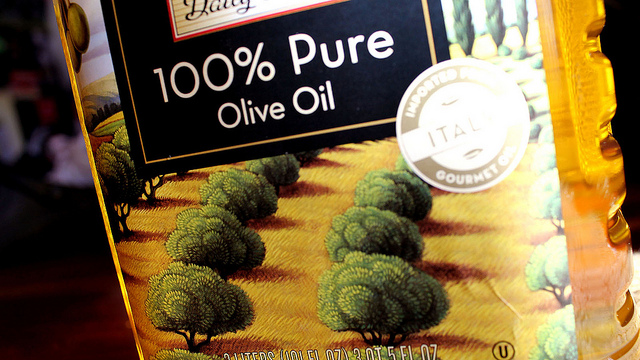“What fats do you use for cooking, Mihaela?”
That’s a question I get a lot.
There is a lot of confusion and conflicting information when it comes to fats.
Everybody is familiar with statements such as: “cholesterol and saturated fats are clogging up your arteries,” and “cholesterol and saturated fats are the cause of heart disease and stroke.” For decades, health care practitioners (including myself) told the public that it’s best to avoid cholesterol, to choose low fat and fat-free products versus full fat ones, and so on.
But before we cast our vote, let’s take a look at how we humans started our life here on Earth.
Our ancestors used animal fats and tropical fats for cooking long before margarines or vegetable oils were invented. They ate food found naturally in their environment. Food scarcity was real, with people often being in a fast and famine cycle.
During the industrialized era, the food we ate changed: the era of processed foods began.
In the 1950s, the diet-heart hypothesis was formulated by Ancel Keys. He managed to show that there was a correlation between the type and the amount of fats and cholesterol consumed and the incidents of heart disease.
Dr. Natasha Campbell-Mc Bride states in her book Put Your Heart in Your Mouth:
“It is completely baffling as to why on earth the scientific community at that time accepted this kind of scientific evidence.”
Today, mainstream medicine doesn’t quite fully accepted that the diet-heart hypothesis is false, which is why we have so much conflicting information about fats. You may hear form your doctor that saturated fats and cholesterol are bad for you, while other practitioners such as Dr. Perlmutter the author of The Brain Grain book just to give you one example, will tell you to bring the butter back and to stay away from vegetable oils and margarines.
My goal today is to help you understand:
- That you need fat in your diet (your brain is 60 % fat by weight, your nerves are covered with a substance called myelin that’s 40 % made of cholesterol, every cell membrane in your body is made of fats and protein);
- How fats are affected by heat, oxygen, and light;
- That not all fats are created equal.
I hope to offer this information so that you will know what fats to buy and how to use them to support your health and wellness goals, and can make informed decisions about this the next time you go shopping,
Heat and oxygen cause structural changes and oxidation to fats. In an oxidized state, the fats become detrimental to our health, contributing to inflammatory processes in the body. Not all fats are equally denatured by heat, however. By the end of this article you’ll understand what fats are heat-sensitive and therefore not your best choice when it comes to cooking.
Fats 101
There are three main categories of fats, saturated fats (SF), unsaturated (poly and mono-unsaturated fats) and trans fats.
Saturated fats are the best fats to use for cooking.
Properties of saturated fats (SF) that make them suitable for high temperature cooking are:
- SF are more stable at high temperature
- They have a high smoking point, meaning the temperature at which they catch fire is high
- They don’t get easily denatured by high heat, oxygen & light
- They have a longer shelf life and are more resistant to rancidity.
The above characteristics make saturated fats the least affected by heat and make them your best choice when it comes to frying, baking, roasting and sautéing.
How do you recognize a saturated fat?
- SF are solid at room temperature and solid in the refrigerator.
Some examples of saturated fats are:
Animal sources:
- Butter and ghee (aka clarified butter, ideally from grass fed, pasture raised cows)
- Lard (fat coming from pork)
- Tallow (fat coming from beef)
- Other fats saved from roasting chicken, duck, goose
- The visible fat on red meat and under the poultry’s skin
Vegetable SF sources include:
- Coconut oil/butter
- Palm kernel oil/butter
Note: all fats found in nature have some degree of saturation, however cholesterol is only found in animal food sources. So, vegetable fats can be saturated but are always free of cholesterol.
There are two kinds of unsaturated fats: poly and mono-unsaturated, also known as PUFA and MUFA.
Saturation is determined by the amount of hydrogens that are feeding into the carbon atoms of the fatty acid chain. The more hydrogen, the more saturated and stable the fat is, and the less hydrogen the more unsaturated the fat is and the more unstable when exposed to oxygen, light and temperature.
Poly-unsaturated fats (PUFA) lack many hydrogen atoms which make them very unstable and easily get denatured by oxygen, heat, and light. They are naturally found in animal and plant-based foods.
Vegetable sources of PUFAs include:
- Vegetable oils such as canola, corn, soybean oil, peanut, etc.
- Seeds oils such as flax, hemp, chia seeds, sunflower, and safflower seed oils, etc.
- All nuts and seeds
Those are your main sources of the essential fatty acids omega-6 (linoleic acid) and omega-3 (alpha-linolenic acid). They are considered essential because we can’t manufacture them, hence we must get them from the foods we eat.
Animal sources of FUFAs:
- Fat from cold-water fish like sardines, mackerel, herring, anchovy, salmon, and trout are also PUFA and they provide us with EPA (eicosapentaenoic acid) and DHA (docosahexaenoic acid). EPA and DHA are produced in our body from the plant sources of omega-3 (e.g. flax oil, or hemp oil). The conversion rate of omega-3 fats into DHA and EPA low, so it’s best to get DHA and EPA from the sources mentioned above or in a form of high quality fish oil supplement.
How do you recognize PUFAs?
- They stay liquid at room temperature, in the refrigerator and the freezer
- A good hemp or flax seed oil will be sold in a dark bottle in the refrigerator section of a supermarket
Now knowing that those fats are highly affected by heat, oxygen and light and they degrade into highly toxic oxidation products when heated would you use them for cooking? I hope you answer no!
I don’t recommend using PUFA oils for cooking and when it comes to vegetable oils (e.g. canola, soybean, corn, peanut) I actually do not recommend using them at all.
Here is why:
- These oils are primarily poly-unsaturated fats, which means they are extremely sensitive to the action of heat, light and oxygen. When oxidized, they become damaged, contributing to the inflammatory processes in the body.
- They are high in omega-6 fats (the inflammatory fats). A good ratio of the omega-6 to omega-3 fats (the anti-inflammatory fats) is 1:1 or 2:1. Our modern diets today supply us with a ratio of 15:1 or as high as 30:1 inflammatory omega-6 to anti-inflammatory omega-3 fats. This is the direct result of increased consumption of vegetable oils that are hidden in our processed and packaged foods. Take a look at a processed food label, and you will almost always find canola oil, sunflower oil or soybean oil listed. Things get even more complicated if those fats are hydrogenated or partially hydrogenated (trans fats).
- They’re also highly refined “food-like substances.” Eating seeds and nuts in their raw un-altered form, we only extract a minute amount of these oils. It is through extensive industrial processing that we are exposed to high levels of these fats. Scientific studies show a correlation between the consumption of polyunsaturated fats and the incidence of cancer, heart disease, diabetes, and other inflammatory related conditions.
What about canola oil? Isn’t that healthy? My favorite question of all.
Canola oil is a rich source of the omega-3 anti-inflammatory fats. So you might assume canola oil is good for you. I believe this is not the case…here’s why:
- Canola oil is extracted from a plant that’s been modified by Canadian scientists to make it non-toxic, since the original seed (rapeseed) has a high euric acid content. Euric acid is toxic to humans and animals (in rats it causes fatty degeneration of the hearth, kidney, adrenals and thyroid). Hybridization methods create a plant with low euric acid content which allows the extraction of the canola oil.
The canola oil we buy in the supermarket today is actually extracted from a plant that didn’t originally exist in nature—it’s a man-made product from start to finish.
Mono-unsaturated fats have more hydrogen atoms than the PUFAs but less than the saturated fats. Hence they are a bit more stable that the PUFAs and less stable tan the saturated fats, they fall somewhere I the middle. These fats are not as sensitive to heat, light and oxygen exposure, as the poly-fats are, however sensitive enough to suffer damage and denaturation while heated.
Food sources of MUFAs:
- Olive oil is a mono-unsaturated fat also known as omega-9 or oleic acid rich oil. Other plants that are good source of the oleic acid are almond, avocado, pecan, cashew, filbert and macadamia nuts.
How do we recognize mono-fats?
- They are liquid at room temperature and become cloudy when refrigerated
- A good olive oil will be sold in a dark glass bottle
My recommendation is to use those fats on cold meals like salads and shakes, or in low-heat dishes like steamed vegetables. Store them in dark bottles away from direct light and heat exposure.
I like to say if you pay extra for a first cold press extra virgin olive oil, just keep it that way.
-
Best used for cooking: Best used for cold dishes: Best to avoid Coconut oil, butter, ghee (from grass fed cows)Lard & any other animal fat rendered from cooking Olive oilFlax & hemp seed oilsNuts and seeds Canola, corn, soybean, peanut, Margarines
~
~
Relephant:
The Skinny on Saturated Fats & Cholesterol.
The Science is Practically Screaming… Don’t Make This Trendy Fat Mistake.
44 Genius Benefits of Coconut Oil.
Author: Mihaela A. Telecan
Editor: Renée P.
Photo: Daniella Segura at Flickr












Read 3 comments and reply